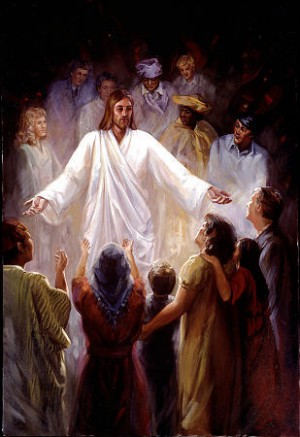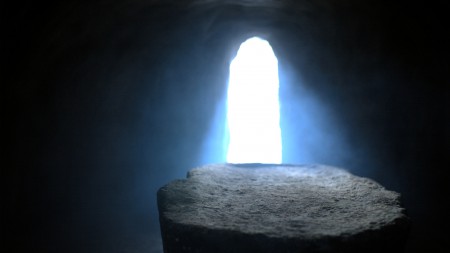Did Jesus Christ Rise from the dead?
Lorem ipsum dolor sit amet, consectetur adipiscing elit. Ut elit tellus, luctus nec ullamcorper mattis.
Fact #4: Jesus’ disciples and followers believed that He rose from the dead and that He appeared to them


The appearances of Jesus are reported by eyewitness testimony.
“The former account I made O Theophilus of all that Jesus began both to do and teach, until the day in which He was taken up, after He through the Holy Spirit had given commandments to the apostles whom He had chosen, to whom He also presented Himself alive after His suffering by many infallible proofs, being seen by them during forty days and speaking of the things pertaining to the kingdom of God”. – Acts 1:1-3The author of this account is the physician (Col. 4:14) and the companion (Philemon 24) of the apostle Paul – Luke. He refers to the “former account”, which was the first narrative that he had written earlier to a man named Theophilus, that we know today as the Gospel of Luke. “Inasmuch as many have taken in hand to set in order a narrative of those things which have been fulfilled among us, just as those who from the beginning were eyewitnesses and ministers of the word delivered them to us, it seemed good to me also, having had perfect understanding of all things from the very first, to write to you an orderly account, most excellent Theophilus, that you may know the certainty of those things in which you were instructed” – Luke 1;1-4.Luke writes both of these two accounts to Theophilus and provides “eyewitness” information so that Theophilus can have an “orderly account” and “know with certainty” the things of the Gospel that he had been instructed in. Luke asserts that he “had perfect understanding of all things from the very first” and on the basis of this knowledge, he writes this “orderly account’.
The information for the resurrection appearances referred to in the New Testament is early first century information and is based on eyewitness sources.
What is the order of the resurrection events?
The sequence of the resurrection appearances are not readily apparent when you read the Gospel accounts. They are not all presented together in any one Gospel account and some are only referred to by Paul in I Corinthians 15. However, the following is an effort to lay out the events of the 40 days in which Jesus showed Himself alive to individuals as recorded in the New Testament. Matthew 28; Mark 16; John 20,21; Acts 1:1-1-12; I Corinthians 15:1-8.Part 1
On Sunday, after the crucifixion as the sun began to dawn, the women followers of Jesus went to the tomb to anoint His body. They were not sure how they would remove the stone, nor did they know if they could even get into the tomb. – Matthew 28:1-8; Mark 16:1-8; Luke 24:1-11. This group consisted of Mary Magdalene, Mary the mother of James and Salome, who were followed by other women who were also followers of Jesus from Galilee – Matthew 27:55,56. Luke 23:55-24:1. (This could also have been two sets of women coming on two separate closely timed occasions). They knew the location of the tomb because they had observed where Jesus’ body was laid – Mark 15:46,47;Luke 23:55,56.
Part 2
The three women saw that the stone had been rolled away –Matthew 28:2. Mary Magdalene runs from the tomb to hurry and tell Peter and John that the stone has been rolled away. She may have arrived just minutes before the other two women or she may have ran away from the tomb as soon as she saw that the stone had been rolled away, leaving the other women behind – John 20:1-3.Part 3
When Mary Magdalene finds Peter and John and tells them the news of the removed stone, they ran toward the tomb. – John 20:3,4.Meanwhile, the other two women, Mary the mother of James and Salome along with the other women from Galilee arrived at the tomb, entered it and saw the angels who assured them that Jesus had risen from the dead . What the time span is for these events we are not told. Were they there for 5 minutes or 25 minutes? The accounts do not provide us with this information. Their response was that they all ran from the tomb in fear and joy to inform the disciples of this news. – Matthew 28:8Part 4
Peter and John arrived at the tomb, entered inside and observed that Jesus’ body was not there. They also noticed the linen strips and burial clothes along with the handkerchief that was bound around Jesus’ head. They noticed that the handkerchief was not next to the burial clothing but that it was wrapped and folded separate from the clothing. They then both left the tomb and returned to their homes. – John 20:4-10.Part 5
Mary Magdalene does not arrive at the tomb for the second time until after Peter and John have left. She comes and sees the open tomb and the stone that has been rolled away and she begins to weep. She stoops down and looks through the entrance of the tomb and sees the two angels. She turns around and supposes that the man standing next to her is the gardener and proceeds ask him if he knows where the body of Jesus has been moved to. Jesus reveals Himself to her and says her name “Mary”. She recognizes Him and her response is that she literally hugs Him. – John 20:11-18. This is the first person that Jesus reveals Himself to that is recorded in the New Testament. This is important because the social standing of women in the first century was such that their testimony was not acceptable in a court of law and if one wanted to establish to his readers the viability of a testimony, he would not utilize the testimony of a woman. Here John makes it clear that this woman was the first person to see the risen Lord. She was also a woman with a dubious background. Luke’s Gospel tells us that Jesus had cast seven demons out of her and this implies that she exhibited sinister and immoral behavior. The reality of this encounter is confirmed by the fact that John simply tells the truth with no attempt to convince the reader with a witness who would command more respect. If he was attempting to create a false storyline, he could have left this detail out or he could have lied and included men as the first eyewitnesses to see Jesus Christ alive. However, he states what actually took place just as all of the other Gospel writers do and plainly states that Mary Magdalene saw the risen Lord. Mary leaves Jesus and goes to tell the disciples that Jesus has appeared to her.Part 6
Meanwhile, as the other women are on their way to tell the disciples what the angel had told them, Jesus appeared to them – Matthew 28:9,10. Their response was that they came and held Him by the feet and worshipped Him. It is again very interesting that the first two appearances of the resurrected Jesus were to women and both John and Matthew record it. If their intent was to try and convince their readers with the most acceptable and believable story line, they would have not included the women as the source of these appearances. However, again their response is to simply tell the truth.Part 7
Later on this Sunday, Jesus appeared to Peter – Luke 24:24, I Corinthians 15:5. None of the elements of this encounter are provided for in the Gospels other than the fact of this appearance.Part 8
Again on this same Sunday, Jesus appeared to two disciples (not a part of the 12 disciples of Christ) on the road to Emmaus – Mark 16:12; Luke 24:13-32. The village of Emmaus was about seven miles from Jerusalem and as they were walking, Jesus met them. They did not recognize Him until later that afternoon and when they finally knew who He was, He vanished from their sight – verses 31,32. Luke tells us that one of these men’s name was Cleopas (verse 18). Early church tradition identifies Cleopas as the brother of Joseph, Mary’s husband. Verses 33-35 states that they went that same hour and returned to Jerusalem and found Jesus’ disciples and reported that they had seen Jesus.Part 9
On this same Sunday in the evening, Jesus appeared to the disciples including the two who had met Him on the road to Emmaus – Luke 24:36-43; Mark 16:9-14; John20:19-25. The disciple Thomas was not present at this meeting with Jesus and later when he heard their account, he did not believe them. He stated that he would not believe that Jesus had risen from the dead unless he could see and touch the wounds in Jesus’ hands and side. Only upon that condition would he believe. – John 20:24,25.Part 10
Eight days later, Jesus appears to the disciples again, this time Thomas was present.- John 20:24-29. Thomas was able to see and touch Jesus and His wounds. His response was that he believed. He said directly to Christ – “My Lord and my God. Jesus said to him, Thomas, because you have seen Me, you have believed. Blessed are those who have not seen and yet have believed”. – John 20:28,29.Part 11
Sometime within the next 40 days (Acts 1:1-3), Jesus appeared to seven disciples on the Sea of Galilee. – John 21:1-19. This was a rather lengthy meeting and provided a significant encounter between Jesus and these seven disciples.Part 12
Jesus appeared again to the apostles and over 500 people, many who were still alive when the account in I Corinthians 15:6 was written.Part 13
Jesus appeared to His half brother James, who as far as we can determine was not a believer in Jesus. This encounter radically changed James and he later became a leader in the church in Jerusalem, wrote the book of James in the New Testament and according to the Jewish historian Josephus, died as a martyr for his confession of faith in Jesus Christ. – I Corinthians 15:7.Part 14
Jesus appeared to a company of believers at His ascension from the Mount of Olives – Mark 16:19,20; Luke 24:44-53; Acts 1:3-12.Part 15
Jesus appeared to Paul, an enemy of the Gospel, on his way to Damascus. This encounter with Christ radically changed Paul’s life and he became one the most significant leaders in the Christian church. – Acts 9:1-22; 22:1-16; 26:9-18.
Was Jesus Actually Seen After His Crucifixion?
The question that has to be answered is this: Did these individuals actually see Jesus Christ alive after He was crucified? The witness of the New Testament documents states that they did indeed see the risen Christ and that these records are based on eyewitness testimony that was written within 30-65 years of the resurrection of Christ. If these encounters and appearances were not real or genuine, then what were they? Could there be a naturalistic explanation rather than the supernatural one provided for us in the New Testament? Later in this presentation, we will examine alternate explanations and theories regarding the resurrection of Christ. However as we will see, the other possibilities require much more faith than the actual, literal resurrection and many are completely incompatible with reality. The New Testament documents provide multiple, independent and early eyewitness based testimony regarding the resurrection. The embarrassing details are not left out (the disciple’s lack of faith and their struggles with doubt; women being the first witnesses of the resurrection…) and the fact that the enemies of the resurrection provide attestation to the Gospel narrative of the empty tomb (Matthew 28:12,13). The link from the apostles to the first century fathers such as Papias, Polycarp, Ignatius and Clement of Rome, provide a second hand source of confirmation that what was reported by the apostles in the New Testament was heard and reconfirmed by the church fathers who were students of the apostles.Ignatius (A.D. 35-107) was the bishop of the church at Antioch and a student of the apostle John. On his journey from prison to martyrdom in the Colosseum in Rome, he wrote the following – “He (Jesus) was crucified and died under Pontius Pilate. He really, and not merely in appearance, was crucified, and died, in sight of beings in heaven, and on earth, and under the earth. He also rose again in three days….On the day of the preparation, then, at the third hour, He received the sentence from Pilate, the Father permitting that to happen; at the sixth hour He was crucified; at the ninth hour He gave up the ghost; and before sunset He was buried. |